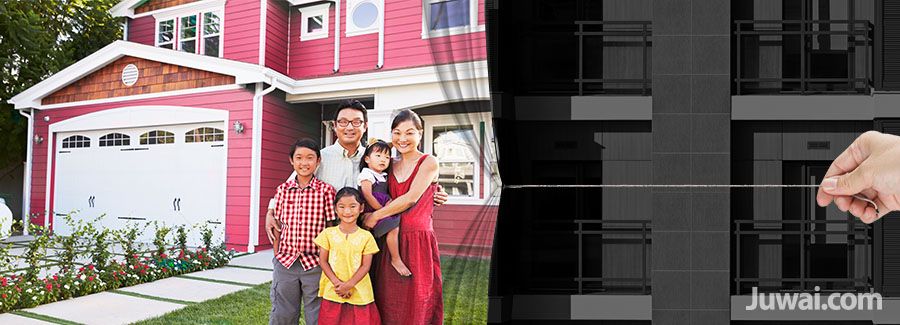You've successfully copied this link.
Chinese upgraders: 3 must-know factors propelling them abroad

In 2010, 50% of China’s urban households still lived in low-quality housing built before 1998.1
Today’s Chinese expect better, thanks to their booming wealth in recent years and China's rapidly growing middle-class population, which has led to more discerning and sophisticated Chinese property investors who are the backbone behind China’s roaring real estate market.
China’s booming real estate market was worth some Â¥1.34 trillion ($195.78 billion) in developers’ sales alone YTD at the end of September 2016.2
And China’s fast-expanding middle-class – estimated to number around 150 million to date3 – is creating additional demand in China’s already red-hot property market, prompting more and more Chinese middle-class to sell their domestic property investments and use the proceeds to buy overseas property.
Rise of the Chinese upgraders, as booming markets boost wealth
It’s vital to note that the Â¥1.34 trillion ($195.78 billion) booked by China’s top real estate developers represented a substantial increase of 85%, when compared with the same period in 2015.2
And the rising market has been a great opportunity for homeowners to liquidate their investments – second-hand home sales turnover in Beijing alone saw brisk 38.8% y-o-y growth so far this year.4 Seeing as property investment is a unanimous favourite for mainland Chinese, this booming market has had a widespread wealth effect in China.
Recent estimates revealed that property accounts for some 66.1% of urban households’ assets5, and long-term Chinese property investors are laughing all the way to the bank as they continue seeing their assets skyrocket in value.
Home prices in Beijing have risen from an estimated ¥8,400 ($1,246) per sq m in 20066 to an astonishing ¥52,104 ($7,733) per sq m by the end of September 2016.7
More importantly, recent reports show that Chinese are increasingly capitalising on this trend by selling their domestic property investments – the 38.8% y-o-y growth in second-hand home turnover during the past year in Beijing alone saw 206,752 homes sold YTD by the end of September.4
This means that a lot of Chinese have become cash-rich in China in tandem with the latest housing boom in China, as this uptick has generated huge gains for homeowners.
For example, a homeowner who bought a standard 100-sq m property in Beijing back in 2006 would have paid ¥840,000 for it. However, he could have sold it for ¥5.21 million in September, generating a profit of some ¥4.37 million ($648,430).
Chinese upgraders keeping property markets abroad buoyant
While many of these Chinese real estate investors are selling off their properties with the intention to upgrade their holdings, many Chinese buyers have grown savvy over the years, and are choosing to look further afield for international property that are imminently more attractive as they offer better quality homes and better investment returns.
Secondhand-home sales in Beijing and Shanghai have grown 38.8% and 25.4%8 y-o-y, respectively, YTD by the end of September, coinciding with a 38% increase in searches on Juwai.com for overseas property in the same time period.
It’s also a driving factor behind why major investment hotspots, like London, have seen a huge upsurge in investment by Chinese, with $2.01 billion booked so far this year, according to JonesLang LaSalle – up 28% on the total invested in 2015.9 Here are three reasons overseas properties now look more attractive than ever to Chinese investors:
#1 Domestic restrictions are reducing investment opportunities
The Chinese government has introduced loan restrictions, and higher taxes for multiple homeowners nationwide.10 With demand running high – even resulting in buyers recently breaking down the door to a real estate project’s sales office in Hangzhou11 – and investors having made big returns in the latest boom, buyers are expanding their horizons and looking overseas for new real estate investment opportunities.
#2 Portfolio diversification
With the prospect of price growth in China weakening in the coming months12, real estate investors are looking to diversify their market exposure, with enticing opportunities in overseas markets at the very top of their list.
#3 International property looks better value
High prices in China mean little bang for the buck for Chinese investors, which makes other locations a better value proposition. After all, $7,733 per sq m in Beijing pales majorly in comparison to $4,801 per sq m in Los Angeles13, $3,300 per sq m in Manchester14, and $1,652 per sq m in Singapore.15 Is it any wonder that Chinese property investors are looking overseas?
An emerging new breed of Chinese upgraders overseas
Interestingly, this trend of upgrading extends to Chinese overseas as well, albeit for differing reasons – an emerging breed of Chinese upgraders has been making waves in the real estate markets abroad, whereby many first-wave buyers are now ageing out of their first property purchase – especially in Australia.16
However, their motivation for upgrading slightly varies from Chinese upgraders in China. This is because most of these Chinese upgraders are not prompted by property price gains or driven by a need to diversify their property portfolio.
Rather, it’s because they’re one of the many Chinese students who chose to stay on in their country of choice after their graduation – most who are now moving on to their next stage in life, whereby many are settling down and starting families.
As such, many Chinese upgraders would choose to sell off their apartments – many which were possibly bought by their parents for them to live in during their student days – to opt for larger houses and terraces to accommodate their expanding family.
Targeting Chinese buyers: Why, How, When, and Where
With Chinese upgraders – regardless of those in China or those who have already moved abroad – on the rise, fundamentals like these present a compelling case for you to step up your targeting of Chinese property investors.
Like any great plan, it all boils down to the why, how, when, and where, and its breaks down like this:
- Why: Beyond investment diversification, Chinese buyers usually think of overseas property as a base for future education, lifestyle, travel, medical care, and retirement, so center your product pitches around these elements to ensure that you have covered all relevant bases that matter to them.
- How: Chinese buyers are increasingly looking online for options, and that’s why Juwai sees some 2 million page visits per month.17 Getting yourself online is absolutely crucial, and Chinese social media and mobile is the most direct and cost-effective way to get behind the Great Firewall of China to connect with China’s expanding market of overseas homebuyers.
- Where: Real estate hotspots in the US, UK, Canada, Australia, and New Zealand18 loom large in buyer’s minds, but it’s hard to find data that keys in specifically on which locations are in most demand for property investment. With Juwai IQ Data, we're able to help give our clients the edge they need in understanding which properties have the best sales potential.
- When: Choosing the right time to market strategically is equally vital, hence preparing for peak sales seasons, such as Chinese New Year and the October Golden Week, is a must when targeting Chinese buyers, simply because millions of Chinese will take the opportunity to travel overseas and property hunt at the same time.
With Colliers forecasting $43 billion worth of Chinese overseas investment in 2016, there’s no time to like the present to step up your efforts to target this increasingly lucrative Chinese market.
Sources: 1. China Securities Journal: 17家ä¸å›½æˆ¿ä¼å‰9个月销售é¢è¾¾1.34万亿元; 2. Guardian: 'This is just the start': China's passion for foreign property; 3. YJBYS: 2016å¹´9月北京二手房交易é‡çŽ¯æ¯”上涨18.9%; 4. IB Times: China’s real estate sector and housing wealth; 5. PED: An introduction of the development of the real estate industry in China; 6. Sina: 9月çœä¼šåŸŽå¸‚房价排行出炉 北京å‡ä»·è¶…5万是é‡åº†7å€; 7. Barrons’s Asia: Are China’s big cities in a real estate bubble?; 8. Shanghai Real Estate Net: 上海链家:2016å¹´1月份上海二手楼市æˆäº¤æœˆæŠ¥; 9. South China Morning Post: Chinese, Hongkongers accelerate property purchases in London; 10. NPR: China imposes restrictions to try to cool real estate bubble; 11. Australian Financial Review: New bubble fears for China's property market; 12. China Daily: Targeted policies will stop property market overheating; 13. Zillow: Los Angeles Home Values; 14. Numbeo: Manchester Property Investment; 15. Global Property Guide: Singapore real estate prices; 16. News.com.au: Chinese ‘upgraders’ adding new twist to real estate boom; 17. LREF: Juwai; 18. Charta Real Estate: Juwai brings Chinese buyers to NZ;
Liked this article? Sign up for free to get Juwai Juwai Asia Market updates!
2025 © Juwai. All Rights Reserved Privacy Policy | Terms of Service


